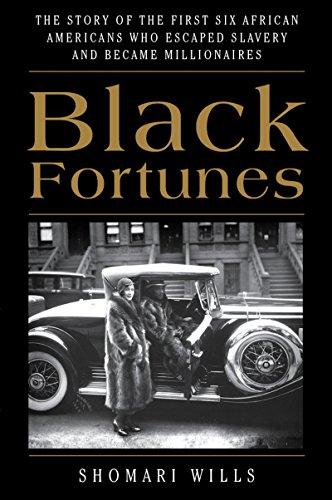
Black Fortunes by Shomari Wills (Socio-Economic History, 2018).
This book tells of the only 6 black folks (4 women, 2 men) who were among the 4,047 millionaires in the United States in the first years after Emancipation. In the end, most of them lost much (sometimes all) of what their hard work, sheer nerve and intelligence had brought them. Their varied stories are by turns both inspiring, frustrating and deeply sad.
Actually, the author opens with a brief prologue about an earlier man–the one person of color to amass such a fortune 20 years BEFORE Civil War led to the official end of slavery in the US. William Leidesdorff was the son of a white Danish sailor and a free black West Indian woman. He came to New Orleans, “passing” for white long enough to begin having success and falling in love. But the honest nature that forced him to reveal his background to his white fiancee spoiled things. He traveled alone to California, then still a Mexican frontier territory. He became a businessman and eventually San Francisco’s top real estate tycoon. When the US took the region in the war with Mexico, he became territorial treasurer and when the gold rush happened in 1848 his various holdings made him the first African American with a net worth of over a million dollars. A fatal seizure killed him one spring night and (in what would be a pattern with too many of the half-dozen wealthy people profiled in more depth here) an opportunitistic white man stepped in to deprive his sole heir (his uneducated estranged and elderly mother in the Virgin Islands) of most of an inheritence that (in today’s money) was worth $38,000,000.
Mary Ellen Pleasant was born free in Philadephia to a black woman and a native of Polynesia. A Quaker-trained merchant, she used the California Gold Rush to assemble a fortune, some of which she used to secretly fund John Brown’s doomed anti-slavery raid on Harper’s Ferry. Later, she became even richer investing in Nevada mining interests and was a leader of California’s slowly losing post-war struggle for civil rights. Yet some onetime white friends and business partners would turn against her in Mary Ellen’s last years. She still had a substantial estate when she died in 1904 ($600,000), but at its height her net worth was far greater.
Robert Church’s white father showed him some affection, but never publically admitted what was obvious to all around them. He didn’t free Robert or his mother, either–the Civil War saw to that. But he did teach his unacknowledged son the business skills that helped Church become the largest landowner in Tennesee and a kind of patron saint of Memphis’s famed Beale Street.
Hannah Elias was the mistress of an indulgent New York millionaire. That caused a serious and lengthy scandal, resulting in ugly court cases and uglier threats of violence. But she used her resources well, building a property empire in what became the black stronghold of Harlem.
Annie Turnbo Malone was a self-taught chemist and developed the first national brand of hair care products for black women. She first mentored and then bitterly competed with “Madam” C. J. Walker, who stole her husband and the formula to some of Annie’s most successful products. While never quite as successful as Annie, Walker was the flamboyant self-promoter and the first wealthy African American woman to go out of her way to flaunt her wealth. That made her infamous to more than a few whites.
And Mississippi schoolteacher-turned real estate developer O. W. Gurley carefully built a district of Tulsa, Oklahoma into a haven for successful middle class blacks that became known as “Black Wall Street.” Yet he’d live to see achievement burn down in a vicious race riot in the 1920s.
This book ably tells the little-known stories of these embattled pioneers in African American enterprise.
Recommended.